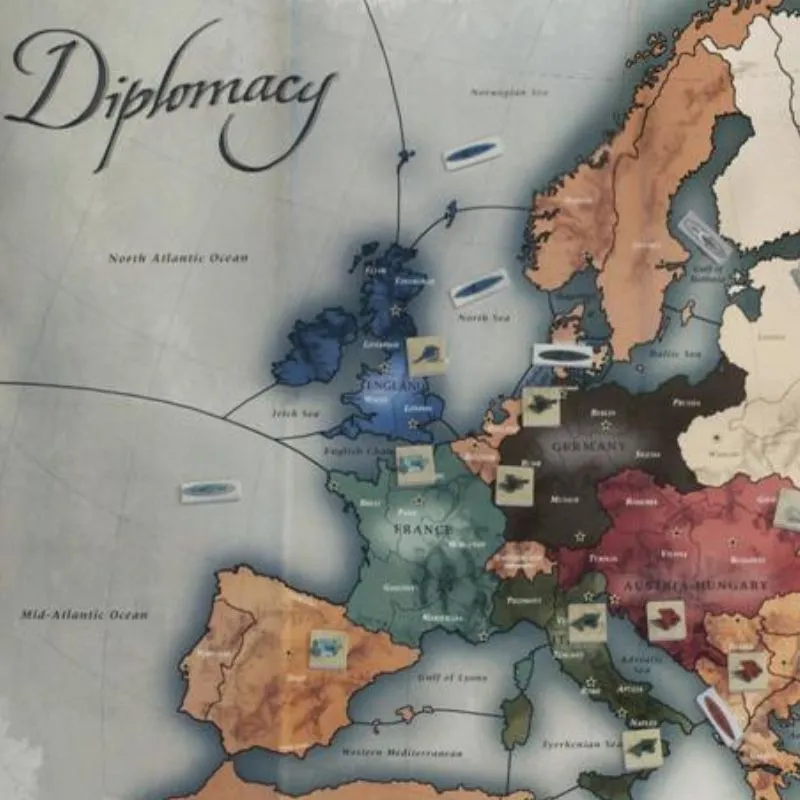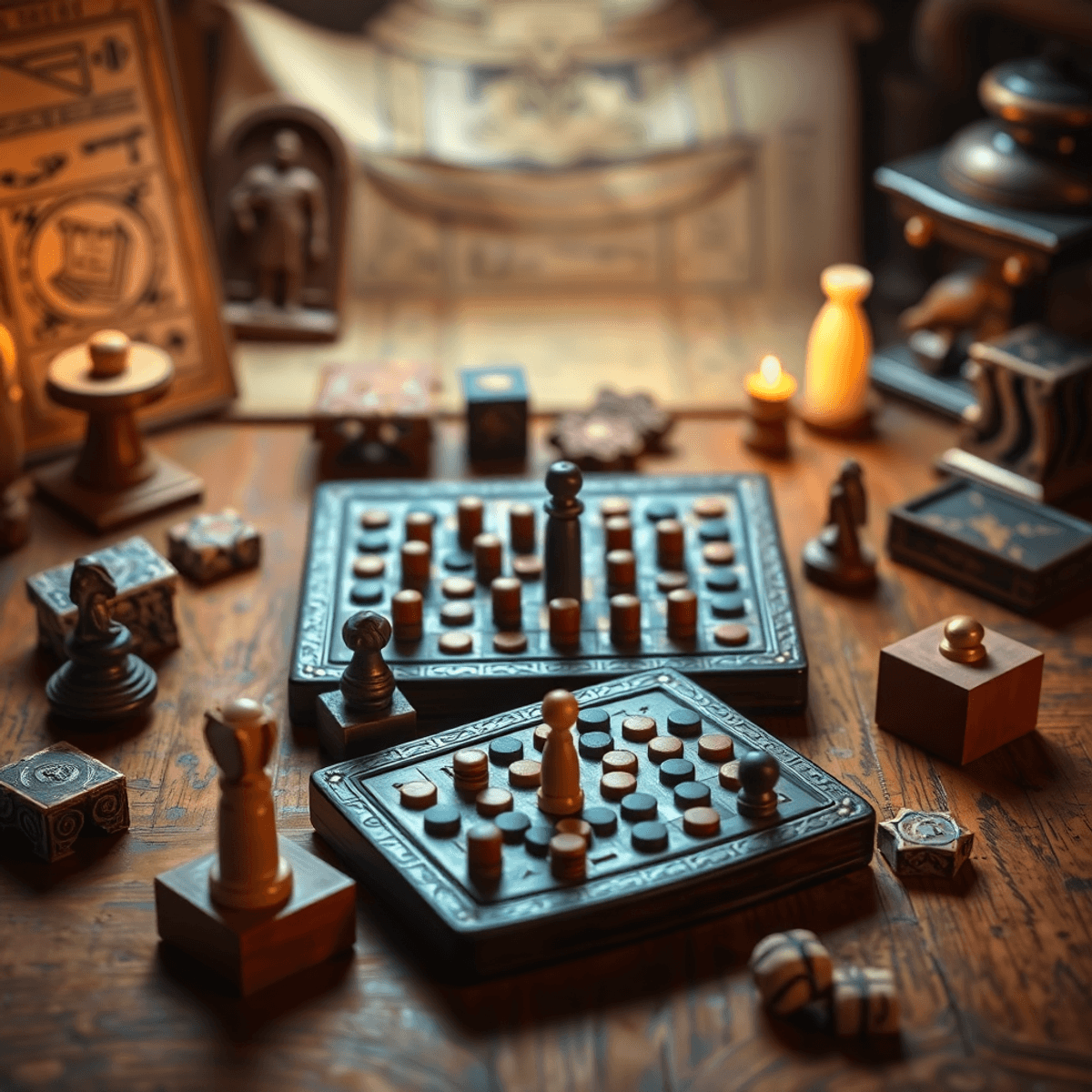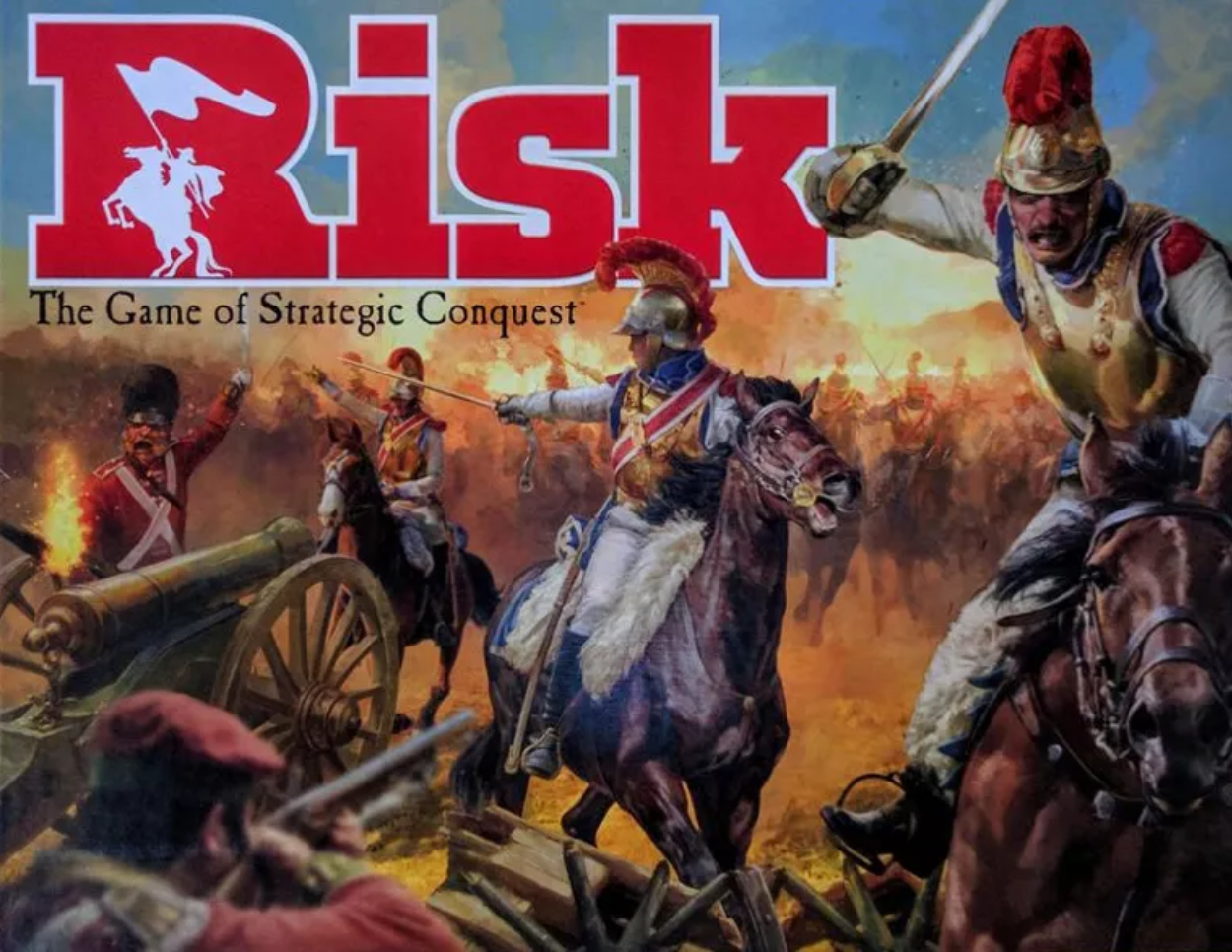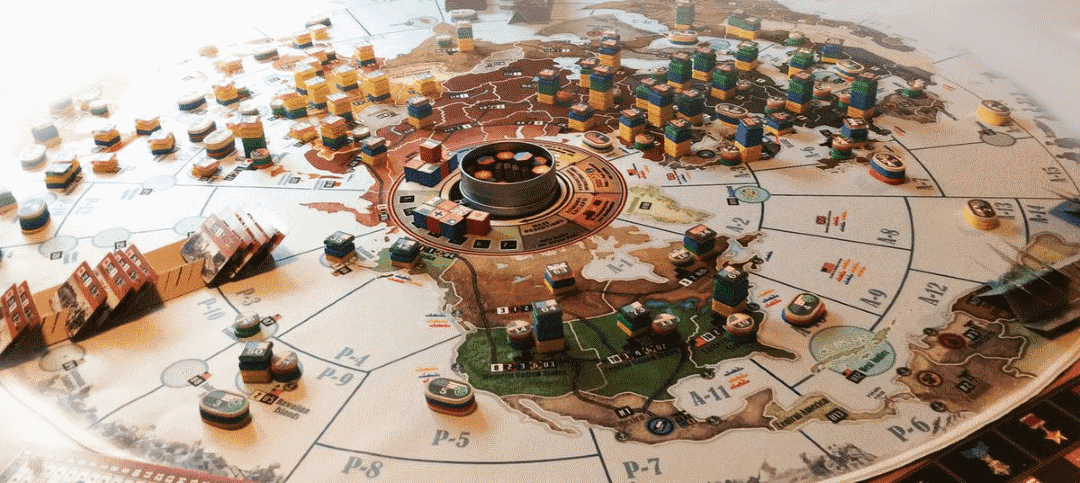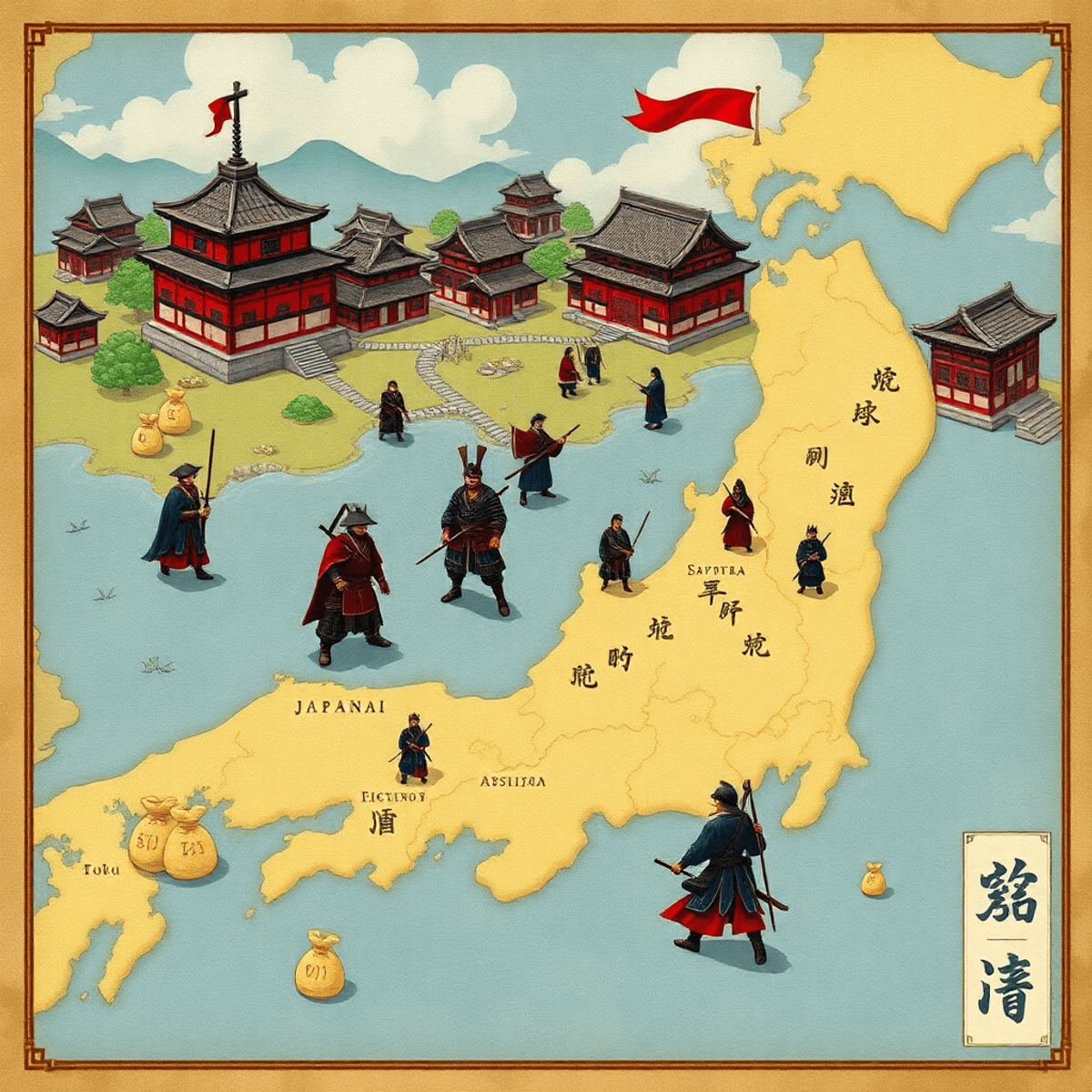
The Shogun board game history is a testament to its lasting impact on the world of tabletop strategy games. As a true masterpiece, Shogun brings the strategic depth and cultural richness of feudal Japan to life. Since its debut, this iconic title has captured the imagination of strategy enthusiasts worldwide, securing its place as a cornerstone in the genre of historical war gaming.
While the allure of feudal Japan continues to inspire countless board game designs, Shogun, however, stands apart thanks to its authentic representation of samurai warfare and political intrigue. In this game, players take on the role of powerful daimyō, commanding armies of skilled warriors across a beautifully crafted map of ancient Japan. As a result, the gameplay captures both the strategic depth and historical flavor of the era.
What Makes Shogun Stand Out
What makes Shogun different from other games in this genre? Picture yourself:
- Deploying loyal samurai warriors to defend your territories
- Sending ninja assassins on secret missions
- Managing your kingdom’s resources measured in koku
- Forming alliances and planning battles with rival warlords
The game’s rich blend of strategic depth and historical accuracy creates an immersive experience that has earned it numerous awards, including the prestigious Origins Awards. In this article, we’ll explore the history of the Shogun board game and how it changed the way we play strategic warfare games.
However, it’s important to note that while Shogun is a standout title, it is part of a much larger tapestry of board games from around the world, each reflecting unique cultural and regional traditions.
Interestingly, many popular games today have roots that trace back to obscure and forgotten board games from history. These lost titles often provide fascinating insights into our gaming past.
As we explore further, we’ll also touch upon the evolution of social board games, which have significantly influenced societal trends and interactions over time.
Moreover, understanding the golden age of board games from the 1950s to 1970s can provide valuable context for our current gaming landscape.
Lastly, we’ll take a brief look at how Victorian era board games have shaped modern gaming trends through their mass production and social leisure impact.
The Evolution of Shogun Board Game
The Shogun board game history reflects a long and fascinating journey through the evolving landscape of tabletop gaming. From its earliest days, the game has undergone multiple editions, each one introducing new and engaging elements to the genre of strategic warfare. Consequently, Shogun has remained relevant and compelling for generations of players, continually adapting while honoring its historical roots.

The Early Years: 1983 Edition by Ravensburger
To begin with, the first edition of Shogun was released by Ravensburger in 1983. Designed by Teruo Matsumoto, this version introduced a two-player format in which the main objective was to capture the opponent’s Shogun piece. Notably, one unique feature of this edition was that the movement ranges of the game pieces would change after each turn. Consequently, this added an unexpected layer of surprise and strategy to the gameplay, keeping players engaged from start to finish.
The Transformation: 1986 Release by Milton Bradley
In 1986, Milton Bradley decided to revamp Shogun as part of their prestigious Gamemaster Series. This new edition made some significant changes to the game:
- The number of players increased from two to five, allowing for larger battles and more strategic alliances.
- Detailed miniature figures were introduced to represent various unit types, bringing a whole new level of immersion to the game.
- Japanese fortress-styled component trays were added for better organization and aesthetics.
- An innovative combat system using twelve-sided dice was implemented, marking a significant step in the evolution of dice in board games.
- Economic management became an integral part of the gameplay with the introduction of the koku currency system.
The success of this version was evident when it won two Origins Awards in 1987 for Best Pre-20th Century Boardgame and Best Graphic Presentation.
A Shift in Branding: Samurai Swords
In 1995, a significant rebranding took place when Shogun was renamed “Samurai Swords.” This change reflected a growing cultural sensitivity towards Japanese culture while still keeping intact the core gameplay elements that fans loved.
Modernization: Ikusa Edition
Fast forward to 2011, when another edition called “Ikusa” was released. This version brought modern production values to the classic design:
- Component quality was enhanced with sturdier materials and finer details.
- The rulebook presentation was streamlined for easier understanding and reference during gameplay.
- Castle-themed storage trays were refined for better organization and aesthetics.
- Artwork was updated while still maintaining traditional Japanese aesthetics.
Legacy and Influence
The impact of Milton Bradley’s version on the gaming industry cannot be overstated. It inspired many war strategy games targeted at adults, paving the way for future titles in this genre. Its combination of resource management, tactical combat, and diplomatic elements set a standard that other games would strive to achieve.
Throughout its various iterations, Shogun has managed to retain a dedicated player base. Each new version has attracted fresh generations of strategy enthusiasts who are drawn to its unique portrayal of feudal Japanese warfare.
As we look back on Shogun’s legacy, it’s important to recognize the influence of its designer Teruo Matsumoto. His contributions have left an indelible mark on the board game industry, inspiring many [famous board game designers](https://tabletoptrove.com/famous-board-game-creators-the-legends-behind-the-games
Gameplay Mechanics That Set Shogun Apart
A major highlight in the Shogun board game history is its gameplay, which stands out for its unique blend of resource management, strategic combat, and diplomatic maneuvering. Players embody powerful daimyō generals, commanding military units across a richly illustrated map of feudal Japan.
Core Military Units:
- Samurai Swordsmen – Elite warriors with superior combat abilities
- Bowmen – Ranged specialists effective in defensive positions
- Ashigaru Spearmen – Basic infantry forming the backbone of armies
- Gunners – Powerful but expensive ranged units
- Ronin Mercenaries – Flexible hired warriors
- Ninja Assassins – Covert operatives for special missions
One of the standout features of Shogun’s gameplay is its unique battle system, which uses six twelve-sided dice to create intense and unpredictable combat encounters. In these situations, tactical positioning and unit composition directly impact the chances of success. Furthermore, each military unit possesses its own combat values and special abilities, enabling players to craft varied strategies based on the strengths and weaknesses of their army makeup. As a result, no two battles play out the same way, adding to the game’s strategic depth.
Resource Management Through Koku
The game’s economic system revolves around koku – the rice-based currency of feudal Japan. Players must find a balance between:
- Territory development
- Army recruitment
- Castle construction
- Mercenary hiring
- Special action funding
One standout feature is the secret planning phase, where players simultaneously allocate their koku using red plastic coins. This creates moments of tension and anticipation as strategies unfold across the board.
Area Control Mechanics with Fortresses
The area control mechanics introduce another layer of depth through the fortress tray system. These Japanese castle-themed components serve both practical and aesthetic purposes, allowing players to organize their units while adding to the game’s immersive atmosphere.
Character Progression for Generals
The leveling system for generals adds character progression elements rarely seen in strategy board games of its era. As generals gain experience through battles, they unlock enhanced abilities and command larger armies, creating compelling narrative arcs within each game session.
Subterfuge Elements with Spies and Assassins
Shogun’s spy and assassination mechanics introduce elements of subterfuge, allowing players to gather intelligence and eliminate key enemy figures. This adds an extra dimension of strategy beyond pure military conflict, rewarding players who master both overt and covert tactics.

Historical Influence on Shogun’s Design
Shogun’s game design is heavily influenced by Japan’s feudal history. The game takes inspiration from the Shogunate, a military dictatorship that ruled Japan from the 12th to 19th centuries. Designer Teruo Matsumoto’s 1983 Ravensburger version captured this period through strategic gameplay that reflected real historical power dynamics.
Key Design Elements Reflecting History
Several key design elements showcase the historical authenticity of Shogun:
- The koku currency system reflects actual medieval Japanese taxation methods
- Castle fortification mechanics mirror genuine defensive strategies from the Sengoku period
- Unit types represent authentic military divisions of feudal Japanese armies
Modern Adaptations Deepening Historical Connections
Modern adaptations of Shogun have further deepened these historical connections:
- The game’s territory control system now accurately represents the complex relationships between daimyō domains
- Battle mechanics incorporate period-specific warfare tactics, such as ninja infiltration and samurai cavalry charges
Evolution of Shogun’s Design Towards Cultural Accuracy
The evolution of Shogun’s design shows a growing commitment to cultural accuracy:
- Earlier versions used simplified Japanese aesthetics
- Recent editions feature authentic architectural details in castle designs
- Modern rulebooks include historical context for game mechanics
- Updated artwork draws from period-accurate armor and weapon designs
Such attention to historical detail is a hallmark of many classic board games, reflecting their timeless journey through history. In Shogun, players don’t just play with Japanese-themed pieces – they step into the roles of actual medieval Japanese warlords commanding their forces across a historically-inspired landscape.
Ikusa Edition: A Modern Take on Shogun
In the evolution of Shogun board game history, the 2011 release of Ikusa marked a pivotal milestone, introducing this beloved strategy title to a new generation of players. Importantly, this updated reprint strikes a careful balance between preserving the classic gameplay mechanics and incorporating modern refinements. As a result, it offers both longtime fans and newcomers an enriched and accessible gaming experience.
Key Improvements in Components:
- Japanese castle-themed trays replace the original styrofoam containers
- Durable cardboard chits substitute plastic swords for turn order tracking
- Enhanced earth-tone colored pieces with detailed sculpting
- Higher quality game board with clearer territory demarcation
The streamlined ruleset maintains the game’s strategic depth while reducing ambiguity. New players can grasp the core concepts quickly through improved rule organization and clearer examples of gameplay situations. Veterans of the original Milton Bradley version will recognize familiar mechanics while appreciating the refined presentation.
Strategic Depth through Secret Planning Phases
Secret planning phases add an extra layer of strategic depth to Ikusa. Players use red plastic coins (koku) to make critical decisions:
- Building defensive fortifications
- Hiring specialized units
- Deploying ninja for reconnaissance
- Planning assassination attempts
These elements reflect the essence of medieval military strategy, where careful planning and foresight are crucial.
Tactical Richness in Combat System
The combat system retains its tactical richness while introducing subtle refinements. Battles unfold through:
- Strategic unit positioning
- Careful management of stacking limits
- Calculated risk assessment using the dice-based resolution system
- Dynamic battlefield conditions that reward adaptability
Engaging Pacing through Mechanical Improvements
The game’s pacing benefits from these mechanical improvements. Each turn flows naturally into the next, creating an engaging rhythm of planning, execution, and adaptation. The refined combat strategies encourage players to think several moves ahead while remaining flexible enough to respond to unexpected developments on the battlefield.
Ikusa’s thoughtful blend of nostalgia and innovation creates an immersive experience that captures the essence of feudal Japanese warfare. The game’s updated components and mechanics work together to deliver a more polished version of the strategic depth that made the original Shogun a classic.
Immersive Gameplay Experience in Shogun Board Game
Furthermore, Shogun’s tabletop experience captures the essence of feudal Japan’s warfare through meticulous attention to historical detail and immersive design elements. Specifically, the game’s map recreates Japan’s diverse landscape—from mountainous interiors to strategic coastal territories—each of which directly impacts military movement and strategic decisions. Therefore, every game session feels like a dynamic historical campaign.
Visual Elements Enhancing Player Immersion
The game’s visual elements enhance player immersion:
- Castle-themed trays designed after authentic Japanese fortifications
- Detailed miniatures representing different military units
- Period-accurate artwork on cards and game components
- Traditional Japanese calligraphy incorporated into design elements
Combat System Reflecting Historical Warfare Tactics
The combat system mirrors historical warfare tactics:
- Strategic positioning of samurai and ashigaru units
- Deployment of ninja for covert operations
- Use of bowmen for ranged attacks
- Integration of gunners representing the emergence of firearms in feudal Japan
Complex Dynamics of Medieval Japanese Warfare
Players experience the complex dynamics of medieval Japanese warfare through resource management and territory control. The koku economy system reflects historical taxation methods, while the daimyō progression mechanics simulate the real-world development of military leaders.
Engaging Sensory Experience
The game’s sound design principles extend to its physical components – from the satisfying clatter of dice during combat resolution to the tactical placement of unit markers. These elements create an engaging sensory experience that draws players deeper into their roles as feudal warlords.
Evolution in Game Design: Tile Placement and Modular Elements
Notably, Shogun also incorporates aspects of tile placement and modular game design, which are key elements in many successful board games. This evolution in game design has allowed for a more immersive gameplay experience, making each session unique and engaging.
Redefining Gameplay: Legacy and Campaign-Based Board Games
Additionally, Shogun can be seen as a part of a larger trend in legacy and campaign-based board games, which have been redefining gameplay by introducing elements that evolve over time, adding depth and complexity to the gaming experience.
Cultural Reflection: Ancient and Medieval Board Games
Finally, it’s interesting to note how Shogun fits into the broader context of ancient and medieval board games. These games not only provide entertainment but also serve as a reflection of the cultural and historical contexts from which they originate.
Conclusion
The enduring legacy of Shogun board game history can be attributed to its seamless fusion of historical authenticity and strategic depth. Even today, it continues to captivate fans with its rich portrayal of feudal Japan’s military tactics and political intrigue. Consequently, the game remains a benchmark for designers aiming to blend educational value with engaging gameplay.
Players looking for similar experiences can check out these other outstanding Japanese-themed strategy board games:
- Rising Sun – A game involving alliances, betrayals, and mythological creatures
- Sekiro: Shadows Die Twice – The Board Game – A challenging tactical game inspired by the video game
- Battle for Rokugan – An area control game set in a fantasy version of feudal Japan
Within the broader context of Shogun board game history, the game’s influence extends far beyond its initial acclaim. In fact, it has played a key role in sparking a lasting appreciation for historical board games that fully immerse players in specific time periods. As a result, Shogun’s legacy continues to inspire a new wave of titles centered around Japanese history and warfare. Moreover, this influence contributes to a growing trend in which underappreciated classics help shape the mechanics, themes, and experiences found in modern tabletop innovation. This phenomenon is part of a larger trend where overlooked board games have influenced modern classics, shaping mechanics, themes, and diverse player experiences.
Additionally, the growth of strategy board games has significantly contributed to this transformation, from their beginnings to contemporary military simulations and their cultural influence. Whether you’re an experienced strategist or new to historical board games, Shogun provides an unforgettable experience into the heart of feudal Japan’s most intense conflicts.


